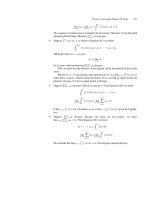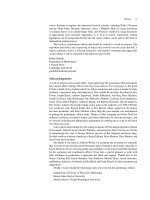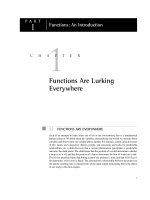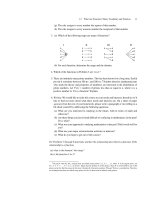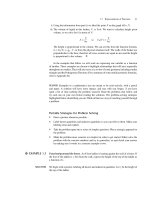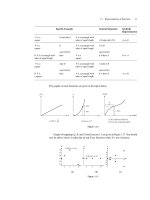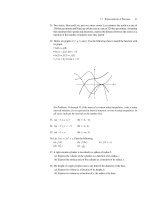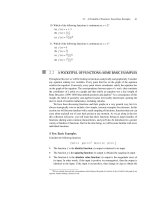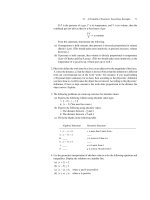Calculus: An Integrated Approach to Functions and their Rates of Change, Preliminary Edition Part 79 ppt
Bạn đang xem bản rút gọn của tài liệu. Xem và tải ngay bản đầy đủ của tài liệu tại đây (266.54 KB, 10 trang )
24
CHAPTER
The Fundamental Theorem
of Calculus
24.1 DEFINITE INTEGRALS AND THE
FUNDAMENTAL THEOREM
We concluded the previous chapter with the Fundamental Theorem of Calculus, version 1.
If f is continuous on [a, b], then
x
a
f(t)dt is differentiable on (a, b) and
d
dx
x
a
f(t)dt =f(x).
One reason this result is so exciting is that we can use it to obtain a simple and beautiful
method for computing definite integrals. Let’s look at how this result helps us compute
b
a
f(t)dt,where a and b are constants.
Definition
A function F is an antiderivative of f if its derivative is f ; that is, F is an antideriva-
tive of f if F
= f .
Recall that if two functions have the same derivative, then they differ only by an additive
constant. In other words, if F and G are both antiderivatives of f (i.e., if F
= G
= f),
then F(x)=G(x) + C for some constant C. Using this terminology, we can rephrase our
last result as follows. Suppose c is between a and b.
761
762 CHAPTER 24 The Fundamental Theorem of Calculus
x
c
f(t)dt is an antiderivative of f(x)because the derivative of
x
c
f(t)dt is f(x).
Let F(x)be any antiderivative of f(x).Then F(x)=
x
c
f(t)dt +Cfor some constant C.
(Any two antiderivatives of f differ only by an additive constant.) It follows that
F(b)=
b
c
f(t)dt +C and F(a)=
a
c
f(t)dt +C.
Suppose that we want to compute
b
a
f(t)dt.Weknow that
b
a
f(t)dt =
c
a
f(t)dt +
b
c
f(t)dt (by the splitting interval property of definite
integrals) Consequently,
b
a
f(t)dt =
b
c
f(t)dt −
a
c
f(t)dt (using the endpoint reversal property of
definite integrals)
= F(b)+C − [F(a)+ C]
=F(b)− F(a)
We’ve shown that
b
a
f(t)dt =F(b)− F(a).
This is the Fundamental Theorem of Calculus, version 2.
The Fundamental Theorem of Calculus, version 2
Let f be continuous on [a, b]. If F is an antiderivative of f , that is, F
= f , then
b
a
f(t)dt =F(b)− F(a).
The Fundamental Theorem tells us that to compute the signed area between the graph of f
and the horizontal axis over the interval [a, b] we need only find an antiderivative F of f
and compute the difference F(b)− F(a).
Recall that our working definition of
b
a
f(t)dt is lim
n→∞
n
i=1
f(x
i
)x, where
we partition [a, b] into n equal pieces, each of length x, and label x
i
= a + ix,
for i = 1, ,n. Calculating F(b) − F(a) is a wonderful alternative to computing
lim
n→∞
n
i=1
f(x
i
)x!
ab
f
F(b) – F(a)
Figure 24.1
The Fundamental Theorem of Calculus gives us a fantastic amount of power when
computing definite integrals. For example, to compute
3
1
3t
2
dt, we need to find a function
24.1 Definite Integrals and the Fundamental Theorem 763
F(t)whose derivative is f(t)=3t
2
.The function F(t)= t
3
comes to mind.
3
1
3t
2
dt = F(3)− F(1)
=3
3
−1
3
=26
It’s as easy as that! The task of evaluating definite integrals essentially amounts to reversing
the process of taking derivatives. It’s like the game show “Jeopardy”; our task is to find a
function whose derivative is what we have been given.
1
The Fundamental Theorem of Calculus is a truly amazing result. Stop and think about
it for a minute. Back in Chapter 5, we set to work on the problem of finding the slope
of a curve. This is an interesting problem all by itself and certainly worthy of a whole
math course. Recently, we’ve been looking at the equally interesting problem of finding
the area under a curve. This seems like a question worthy of another whole separate
math course. But we have just found that these two questions are intimately related. The
process of evaluating definite integrals involves the process of antidifferentiating—the
process of finding derivatives in reverse! When we first started looking at areas, would
you have guessed that such a marvelous relationship would exist? Probably not. But it does.
Astounding!
Take a deep breath and think about this for a minute. Then go and explain this amazing
result to someone—your roommate, your best friend, your grandmother, your goldfish, or
all of them!
Using the Fundamental Theorem of Calculus
We’ll begin by applying the Fundamental Theorem to a familiar example, an example we
could do without the Theorem.
◆
EXAMPLE 24.1 Find the area under v(t) = 2t + 5 on the interval t = 1tot=4.
This is the example we looked at in Section 22.1, Example 22.5 in the following guise:
v(t) = 2t + 5 is the velocity of a cheetah on the interval [1, 4]. How far has the cheetah
traveled from t = 1tot=4?
SOLUTION The area is
4
1
(2t + 5)dt.Toevaluate this using the Fundamental Theorem of Calculus we
need an antiderivative of 2t + 5. The derivative of t
2
is 2t and the derivative of 5t is 5, so
F(t)= t
2
+5t is an antiderivative of 2t + 5.
4
1
(2t + 5)dt=F(4)−F(1)
=(4
2
+5· 4)− (1
2
+5· 1)
=30
This is the same answer we obtained by calculating the area of the trapezoid directly.
1
It turns out that this game of “Jeopardy” is in fact harder to play than is the derivative game. In general it’s simpler to
differentiate than it is to find an antiderivative. Try finding a function whose derivative is e
x
2
if you doubt this.
764 CHAPTER 24 The Fundamental Theorem of Calculus
t
v(t)
5
10
15
20
1 234
(1, 7)
(4, 13)
Figure 24.2
In fact, using the Fundamental Theorem of Calculus to solve this problem is the approach
that was referred to as the “second mindset” in Chapter 22.1, Example 22.5b. The velocity
of the cheetah is given by v(t). Looking for a position function s(t) is equivalent to
looking for a function F whose derivative is v(t). Finding the displacement by computing
change in position, s(4) − s(1), is essentially what we find when computing F(4)− F(1).
F(t)= s(t) + C, and the constants cancel when we compute F(4)− F(1).
◆
EXERCISE 24.1 Any antiderivative of 2t + 5 can be written in the form F(t)= t
2
+ 5t + C. Show that
when using the Fundamental Theorem to evaluate the integral it doesn’t matter which
antiderivative is used.
NOTATION: The notation F(x)
b
a
is used as a shorthand for F(b)− F(a).It is convenient
because it allows us to write F(x)explicitly before evaluating.
◆
EXAMPLE 24.2 Compute
1
0
x
2
dx.
1
(1, 1)
f(x) = x
2
f
x
Figure 24.3
SOLUTION We want an antiderivative of x
2
, i.e., we’re looking for a function whose derivative is x
2
.
F(x)=
x
3
3
is such a function.
1
0
x
2
dx =
x
3
3
1
0
=
1
3
− 0
=
1
3
◆
24.1 Definite Integrals and the Fundamental Theorem 765
◆
EXAMPLE 24.3 Compute
5
e
7
w
dw.
f
w
e
5
Figure 24.4
SOLUTION
b
a
kf(x)dx =k
b
a
f(x)dx (the constant factor property), so we can rewrite this.
5
e
7
w
dw = 7
5
e
1
w
dw We want a function whose derivative is
1
w
. F(w)= ln w works.
= 7
ln w
5
e
= 7[ln 5 − ln e]
= 7[ln 5 − 1]
◆
Notice that calling the variable in the integrand w instead of t or x makes no difference;
the name of the variable has no impact. Also note that the properties of definite integrals we
found in Section 22.4 are coming in very handy here and that these properties agree with
the properties of derivatives. The following are of particular computational importance.
2
b
a
kf(x)dx =k
b
a
f(x)dx and
d
dx
kf(x)=k
d
dx
f(x)
b
a
f(x)+g(x) dx =
b
a
f(x)dx +
b
a
g(x) dx and
d
dx
(f + g) =
df
dx
+
dg
dx
◆
EXAMPLE 24.4 Suppose that water enters a reservoir at a rate of r(t) = 40,000 + 60,000 cos t gallons per
month, where t is measured in months. What is the net change in water level between t = 0
and t = 2?
SOLUTION To find the net change we calculate the signed area under the rate of change function.
2
When applicable, symmetry considerations can save us a lot of work.
766 CHAPTER 24 The Fundamental Theorem of Calculus
2
0
(40,000 + 60,000 cos t) dt
=
2
0
10,000(4 + 6 cos t) dt
= 10,000
2
0
(4 + 6 cos t) dt constant factor property
= 10,000
2
0
4 dt + 6
2
0
cos tdt
additive integrand property
= 10,000
4t
2
0
+6(sin t)
2
0
sin t is an antiderivative of cos t
= 10,000
8 − 0 + 6 sin 2 − 6 sin 0
= 10,000
8 + 6 sin 2
Observe that r(t) is the rate function for water entering the reservoir. The function giving
the amount of water in the reservoir at time t is an antiderivative of r(t). The net change is
the difference between the final and initial amount. While the antiderivative that we use is
not necessarily the amount function, it differs from the amount function by a constant, so
the net change in amount is preserved.
◆
◆
EXAMPLE 24.5 Compute
1
0
1
1+x
2
− 3x
9
dx.
SOLUTION
1
0
1
1 + x
2
− 3x
9
dx =
1
0
1
1 + x
2
dx − 3
1
0
x
9
dx
For the first definite integral we are looking for a function whose derivative is
1
1+x
2
. arctan x
is such a function. For the second we are looking for a function whose derivative is x
9
.
x
10
10
is such a function.
1
0
1
1 + x
2
− 3x
9
dx = arctan x
1
0
− 3 ·
x
10
10
1
0
= [arctan 1 − arctan 0] − 3
1
10
−
0
10
=
π
4
− 0 − 3
1
10
=
π
4
−
3
10
How did we know that an antiderivative of
1
1+x
2
is arctan x? We had to remember the
derivative of arctan x. (It’s actually a bit surprising that every antiderivative of
1
1+x
2
is of
the form arctan x + C.)
How did we know that an antiderivative of x
9
was
x
10
10
? We might make a first guess of
x
10
but the derivative of x
10
is 10x
9
. This is almost what we want, but we don’t want the
24.1 Definite Integrals and the Fundamental Theorem 767
constant of 10 out front. To get rid of it, we divide by 10:
d
dx
1
10
x
10
=
1
10
· 10x
10
= x
10
,
as desired.
◆
Appreciating the Fundamental Theorem
Before arriving at the Fundamental Theorem of Calculus we did not have a convenient,
widely applicable method of evaluating definite integrals. In this section we tackle two prob-
lems,
1
0
x
2
dx (Example 24.2), and
π
0
sin xdx,without using the Fundamental Theorem
of Calculus. The purpose of this exercise is both to encourage you to recall the limit defini-
tion of the definite integral (essential in applications and in instances where we can’t find an
antiderivative) and to help you develop an appreciation for the power of the Fundamental
Theorem.
◆
EXAMPLE 24.6 Evaluate
1
0
x
2
dx using the definition of the definite integral but not using the Fundamental
Theorem of Calculus.
SOLUTION We begin by partitioning [0, 1] into n equal subintervals labeled as shown.
∆ x ∆ x =
∆ x∆ x
x
0
x
1
x
2
x
3
x
n–1
x
n
=
=
0
. . .
1
n
=
2
n
=
3
n
=
n–1
n
=1
=
n
n
1
n
Figure 24.5
Each subinterval has width x =
1
n
. x
k
= kx =
k
n
, for k = 0, 1, ,n,so
x
0
=0, x
1
= 1/n, x
2
= 2/n, , x
n
=n/n = 1.
1
0
x
2
dx is defined to be lim
n→∞
R
n
. We begin by constructing R
n
, the general right-hand
sum. Let f(x)= x
2
and refer to Figure 24.6.
∆ x
x
y
x
1
x
2
x
3
x
n
f(x
n
)
Figure 24.6
The height of the first rectangle is f(x
1
),the height of the second is f(x
2
),and so on.
1
0
x
2
dx = lim
n→∞
R
n
= lim
n→∞
n
i=1
f(x
i
)x
.
768 CHAPTER 24 The Fundamental Theorem of Calculus
1
0
x
2
dx = lim
n→∞
f(x
1
)x + f(x
2
)x + f(x
3
)x +···+f(x
n
)x
= lim
n→∞
f(x
1
)+f(x
2
)+f(x
3
)+···+f(x
n
)
x
= lim
n→∞
(x
1
)
2
+ (x
2
)
2
+ (x
3
)
2
+···+(x
n
)
2
x (because f(x)=x
2
)
= lim
n→∞
1
n
2
+
2
n
2
+
3
n
2
+···+
n
n
2
1
n
(because x
k
=
k
n
, x =
1
n
)
= lim
n→∞
1
2
+ 2
2
+ 3
2
+···+n
2
n
3
In order to evaluate this limit we must express 1
2
+ 2
2
+ 3
2
+ ···+n
2
in closed form.
Although it is not a geometric sum, it can be expressed in closed form as follows.
1
2
+ 2
2
+ 3
2
+···+n
2
=
n(n + 1)(2n + 1)
6
This identity has been delivered to you like manna dropped from heaven. It can be proven
by mathematical induction.
3
We use it to obtain
1
0
x
2
dx = lim
n→∞
n(n+1)(2n+1)
6n
3
.
To evaluate this limit think back to the work we’ve done with rational functions and
consider lim
x→∞
x(x+1)(2x+1)
6x
3
. The degree of the numerator and denominator are equal
(both are of degree 3), so the limit is given by the fraction formed by the leading coefficients
of the numerator and denominator.
4
lim
x→∞
x(x + 1)(2x + 1)
6x
3
=
2
6
=
1
3
.
Therefore,
lim
n→∞
n(n + 1)(2n + 1)
6n
3
=
1
3
.
We conclude that
1
0
x
2
dx =
1
3
.
◆
◆
EXAMPLE 24.7 Find the area under one arc of sin x without using the Fundamental Theorem of Calculus.
1
sin x
x
one arc of sin x
π
Figure 24.7
3
Refer to Appendix D: Proof by Induction.
4
For large n this fraction “looks like”
2x
3
6x
3
, the dominant term of the numerator over the dominant term of the denominator.
24.1 Definite Integrals and the Fundamental Theorem 769
SOLUTION Consider
π
0
sin xdx. Touse the limit definition of the definite integral we begin by
chopping [0, π] into n equal subintervals labeled as shown.
0 = x
0
. . .x
1
x
2
x
3
x
n
= π
Each subinterval has width x =
π
n
. x
k
= kx =
kπ
n
, for k = 0, ,n,so
x
0
=0, x
1
= π/n, x
2
= 2π/n, x
3
= 3π/n, , x
n
=nπ/n = π .
Let f(x)=sin x. We know
π
0
sin xdx= lim
n→∞
R
n
= lim
n→∞
n
i=1
f(x
i
)x
.
π
0
sin xdx= lim
n→∞
f(x
1
)x + f(x
2
)x + f(x
3
)x +···+f(x
n
)x
= lim
n→∞
f(x
1
)+f(x
2
)+f(x
3
)+···+f(x
n
)
x
= lim
n→∞
sin x
1
+ sin x
2
+ sin x
3
+···+sin x
n
x
π
0
sin xdx= lim
n→∞
sin(π/n) + sin(2π/n) + sin(3π/n) +···+sin(nπ/n)
(π/n)
We look up, but no manna drops down from heaven. Alas, we have no way of ex-
pressing [sin(π/n) + sin(2π/n) + sin(3π/n) + ···+sin(nπ/n)] in closed form; we have
a problem evaluating this limit. Without using the Fundamental Theorem, we can only ap-
proximate
π
0
sin xdx.There are problems at the end of this section asking you to do this.
◆
EXERCISE 24.2 Although we can write what we’ve done in Example 24.7 using summation notation, that
is just shorthand, not a closed form; it is nice and compact, but it does not help us evaluate
the limit. As an exercise, express what we’ve done using summation notation and compare
your answer with what is given below.
π
0
sin xdx= lim
n→∞
n
k=1
sin
kπ
n
π
n
If we do use the Fundamental Theorem of Calculus, the problem of computing
π
0
sin xdx
becomes straightforward. We look for a function whose derivative is sin x. We might first
guess cos x.
d
dx
cos x =−sin x, which is almost what we want.
d
dx
(− cos x) = sin x.
Therefore
π
0
sin xdx=−cos x
π
0
=−cos π − (− cos 0)
=−(−1)+1
=2.
770 CHAPTER 24 The Fundamental Theorem of Calculus
Pause for a moment to admire what we’ve discovered. The area under one arc of sin x is 2.
Exactly. Remarkable!
Is the moral of Example 24.7 that the limit definition of the definite integral is merely
academic? No! In practice, we use the Fundamental Theorem of Calculus to compute
definite integrals exactly whenever we can, but sometimes it is difficult (or impossible) to
find an antiderivative of the integrand. (For instance, try to find a function whose derivative
is e
−x
2
. But don’t try for too long; it’s impossible.
5
) In this case, the best we can do is
to approximate the definite integral. The limit definition of derivative gives us a means of
approximation. For example, since
π
0
sin xdx= lim
n→∞
n
k=1
sin
kπ
n
π
n
,
we know that
π
0
sin xdx≈
n
k=1
sin
kπ
n
π
n
, for n large.
While this latter sum is tedious to compute by hand for n large, a computer or programmable
calculator can deal with it easily. We’ll return to numerical approximations in Chapter 26.
In addition to providing a computational tool for approximating definite integrals, the limit
definition allows us to apply the work we’ve done with definite integrals to new situations.
This will be our focus in Chapter 27 and again in Chapter 29.
The Fundamental Theorem of Calculus, Take Two
The Fundamental Theorem of Calculus tells us that we can find the area under the graph
of a continuous function f on the interval [a, b]byfinding any antiderivative F of f and
evaluating the difference F(b)− F(a).We’veseen that this is an amazing and powerful
result. We now show you (through examples) that if the integrand is thought of as a rate
function, then the Fundamental Theorem of Calculus tells us something we’ve known for
some time.
◆
EXAMPLE 24.8 A camel is walking along a straight desert road with velocity f(t).Howcan we express the
camel’s displacement from time t = a to time t = b?
SOLUTION On the one hand we can partition the time interval [a, b] into n equal pieces, approximate the
camel’s displacement on each subinterval by assuming constant velocity on the subinterval,
sum the displacements, and take the limit as n grows without bound. The camel’s net change
in position is given by
b
a
f(t)dt.
On the other hand, f(t) is the velocity function, so f(t)=
ds
dt
, where s(t) gives the
camel’s position at time t. s
(t) = f(t),sos(t) is an antiderivative of f(t).Weknow that
if we can find s(t), then the camel’s net change in position must be given by
s(b) − s(a).
5
It is impossible to find such a function unless you’re willing to use an infinite polynomial.
